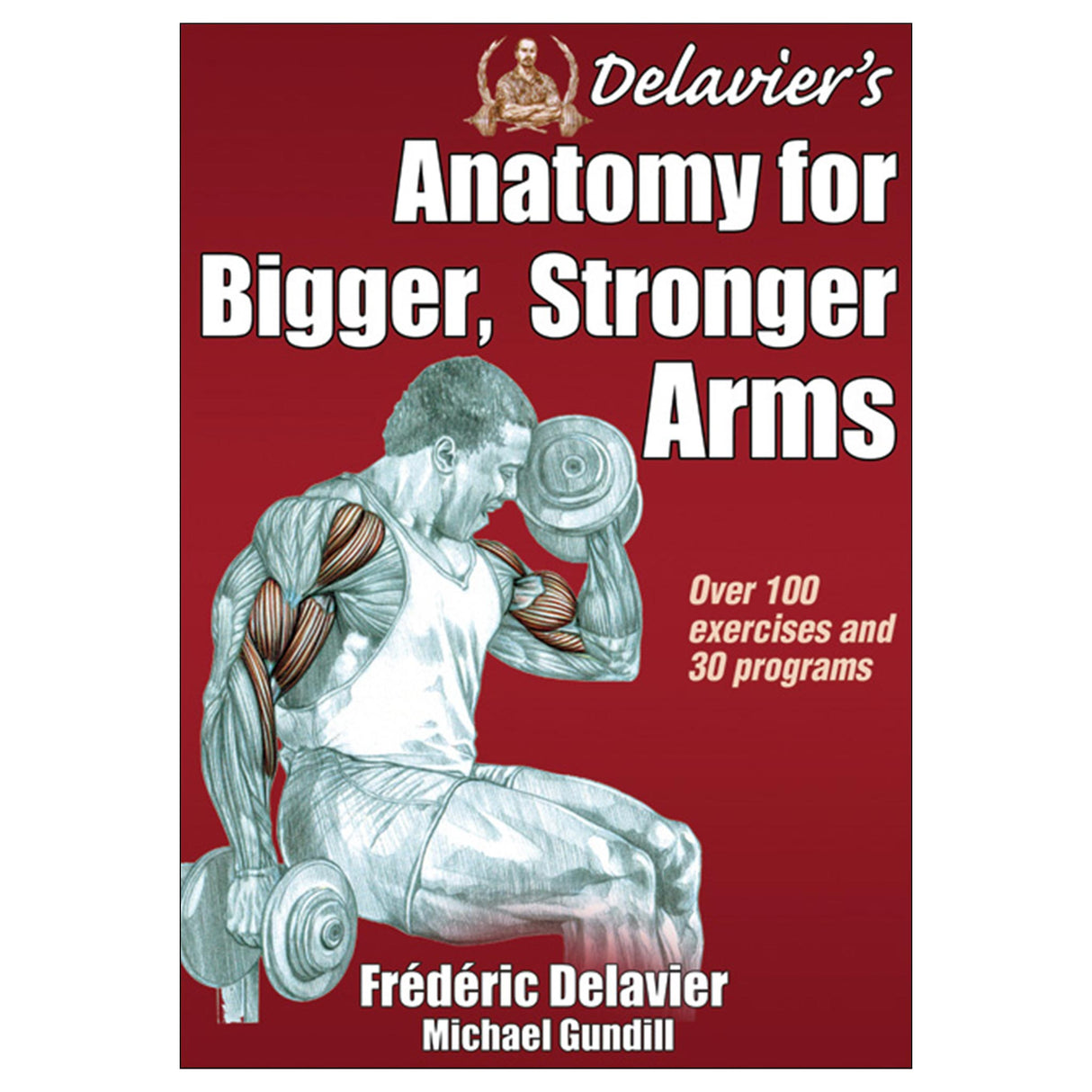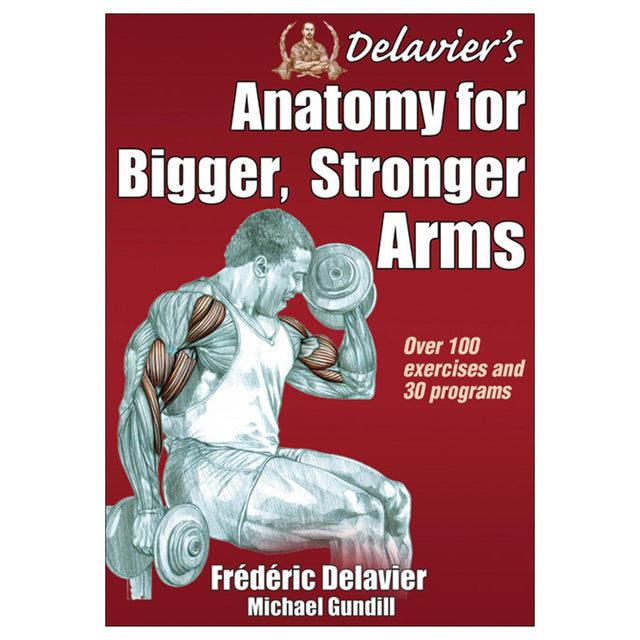Delavier's Anatomy for Bigger, Stronger Arms
Author: Frederic Delavier, Michael Gundill
$34.95 CAD
Delavier’s Anatomy for Bigger, Stronger Arms is your guide to the massive biceps, triceps, and forearms you’ve always wanted.
Over 330 full-color photos and 130 anatomical illustrations allow you to go inside more than 100 exercises to see how muscles interact with surrounding joints and skeletal structures and how variations, progressions, and sequencing can isolate specific muscles to help you achieve targeted results. It’s like having an X-ray of each exercise!
Delavier’s Anatomy for Bigger, Stronger Arms includes over 30 proven programs for strength, size, and sport performance. You’ll also learn the most effective exercises for your goals; how to determine weight, repetition, and frequency; how to prevent tendinitis, muscle tears, and forearm and wrist pain; and strategies for varying your routine to ensure constant gains and optimal results.
Whether you’re looking to quickly increase the size of your biceps or correct imbalances between the heads of your triceps, Delavier’s Anatomy for Bigger, Stronger Arms provides serious training for serious results. It’s all here and in all the stunning detail that only Frédéric Delavier can provide!
The former editor in chief of PowerMag in France, author and illustrator Frédéric Delavier is a journalist for Le Monde du Muscle and a contributor to Men’s Health Germany and several other strength publications. His previous publications, Strength Training Anatomy and Women’s Strength Training Anatomy, have sold more than 2 million copies.
Part 1
What You Need to Know Before You Begin
1. Develop Your Program
20 Steps to Developing Your Arm Workout Program
1. How should you define your goals?
2. How many arm workouts should you do each week?
3. Which days should you work out?
4. Should you work the biceps and triceps separately?
5. What time of day should you work out?
6. How many sets of arm exercises should you do for each muscle?
7. How should you adjust the volume of work?
8. How many exercises should you do during each workout?
9. When should you change exercises?
10. How many repetitions should you do in each set?
11. How quickly should you do repetitions?
12. How do you adjust the range of motion in an exercise?
13. How long should a workout last?
14. How much rest time should you take between sets?
15. How do you determine the most appropriate weight for each exercise?
16. When should you increase the weight?
17. How much rest time should you take between exercises?
18. How do you select exercises based on your anatomomorphology?
19. When should you change your program?
20. Should you take a vacation?
Keep a Workout Notebook
Rate of Progress
Techniques for Increasing Intensity
Volume or Intensity?
Theory of Absolute Strength: A Good Beginning Strategy
Inroad Theory: An Advanced Technique
Summary of These Two Theories
Synchronizing Cycles
Should You Train to Muscle Failure?
Beyond Failure
Stop-and-Go
Burn
Continuous Tension
Unilateral Training
Supersets
Circuits
How Should You Breathe During a Workout?
2. Build Your Arms Quickly!
Secrets of Biceps Anatomy
Anatomical Considerations
Roles of the Biceps
The Secret to Huge Biceps
Hand Position Affects the Strength of the Biceps
Hand Position Affects the Strength of the Brachioradialis
Let’s Talk About Size
A Muscle’s Length–Tension Relationship: The Key to Strength
Secrets of Triceps Anatomy
Anatomical Considerations
Roles of the Triceps
The Secret to Huge Triceps
Secrets of Forearm Anatomy
Anatomical Considerations
Roles of the Forearms
Practical Observations: The Forearm, a Muscle of Extremes
Part 2
Weak Areas and Pathologies
1. Understanding Weak Areas
Four Obstacles to Developing the Biceps
Small Biceps
Short Biceps
Imbalance Between the Long and Short Heads
Small Brachialis
Two Obstacles to Developing the Triceps
Small Triceps
Imbalance Between the Heads
Five Obstacles to Developing the Forearms
Forearms Are Too Small
Forearms Are Too Large
Small Brachioradialis
Imbalances Between Flexor and Extensor Muscles
Weak Hands
2. Strengthening Weak Areas
Strategies for Developing the Biceps
Anatomical Dilemma: You Must Work the Biceps From Every Angle in Order to Develop It!
Anatamomorphological Dilemma: Should You Straighten Your Arms During Curls?
Are You a Hypersupinator or a Hyperpronator?
Adapting Exercises to Your Morphology
Biomechanical Dilemma: Are Curls a Compound Exercise for the Biceps?
If Classic Curls Don’t Produce the Results You Expect
Strategies for Developing the Triceps
Learn to Feel the Triceps Well
Strategies for Correcting Imbalances Between the Heads
Is a Fixed or Rotating Schedule Best?
Strategies for Developing the Forearms
Get Bigger Forearms
Develop the Brachioradialis
Correct Imbalances in the Forearms
Strengthen Your Grip
Prevent Your Forearms From Interfering With Your Biceps Training
3. Preventing Pathologies
Understanding Biceps Pathologies
Causes of Pain in the Biceps
1. Vulnerability of the Tendon of the Long Head of the Biceps
2. Three Types of Biceps Tears
3. Focus on Problems With the Labrum
Understanding Triceps and Elbow Pathologies
1. Understanding Elbow Pain
2. Types of Triceps Tears
Understanding Forearm and Wrist Pathologies
Factors That Predispose You to Forearm Pain
Tendinitis in Muscles Attaching to the Epicondyles
Prevent Pain in the Forearms and Wrists
Goals of a Strength Training Program for Preventing Wrist Injuries
Part 3
The Exercises
1. Beginning Exercises
You Do Not Need Much Equipment to Work Your Arms at Home
Dumbbells
Pull-Up Bar
Elastic Bands
Exercises for the Biceps
Pull-Up
Supinated Curl
Hammer Curl
Concentration Curl
Biceps Stretch
Exercises for the Triceps
Narrow Push-Up
Seated or Standing Triceps Extension With Dumbbells
Lying Triceps Extension With Dumbbells
Reverse Dip
Triceps Kickback
Triceps Stretch
Exercises for the Forearms
Reverse Curl
Wrist Curl
Wrist Extension
Forearm Stretch
2. Advanced Exercises
Advanced Exercises for the Biceps
Supinated Curl With a Machine
Low-Pulley Curl
Cable Stretch Curl
Incline Curl
Preacher Curl With a Scott Curl Bench
Brachialis Curl
Advanced Exercises for the Triceps
Narrow-Grip Bench Press
Dip
Lying Triceps Extension With a Bar or Machine
Seated or Standing Triceps Extension With a Bar or Machine
Cable Push-Down
Advanced Exercises for the Forearms
Hanging From a Pull-Up Bar
Squeezing a Hand Grip
Wrist Roller and Power-Flexor
Pronosupination With a Bar
Part 4
Arm Workout Programs
Home-Based Programs Using Little Equipment
Beginner Programs
Intermediate Programs
Advanced Programs
Programs for the Gym
Beginner Programs
Intermediate Programs
Advanced Programs
Strength Training Programs Designed for Your Sport
Racket Sports
Rugby, Football, and Team Contact Sports
Basketball, Volleyball, and Handball
Downhill Skiing
Combat Sports
Track and Field Throwing Events
Swimming
Golf
Rowing
Kayaking and Sailing
Climbing
Arm Wrestling
Powerlifting Program for the Bench Press









